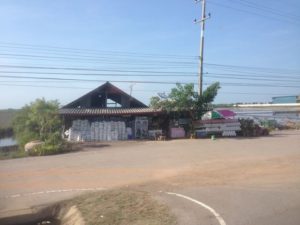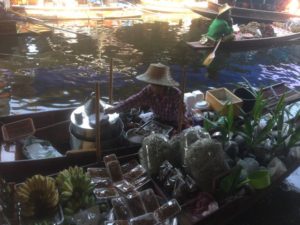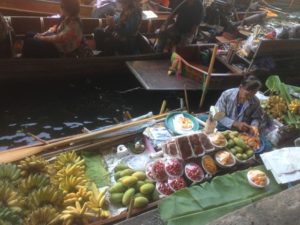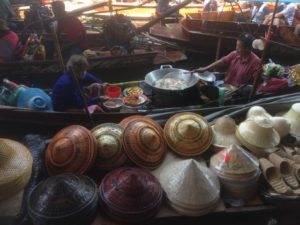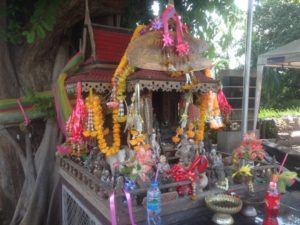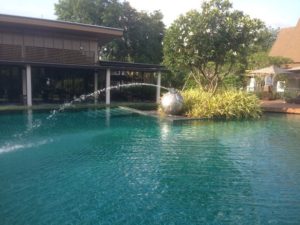We departed Bangkok at 7:30, driving past salt flats where sea salt is harvested,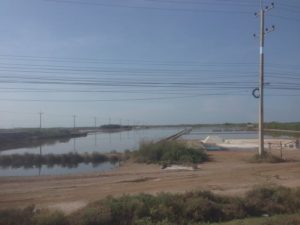
and arriving at the Dammon Saduak Floating Market at around 9:30.
We took long tail boats through tiny canals bordered with houses and tropical flowers.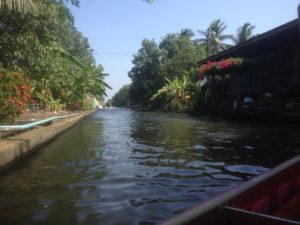 Most house and businesses we pass have spirit houses in the yard.
Most house and businesses we pass have spirit houses in the yard.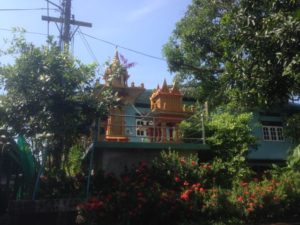
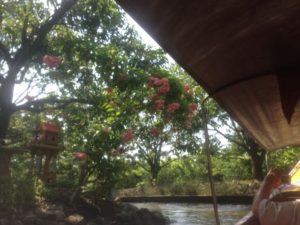
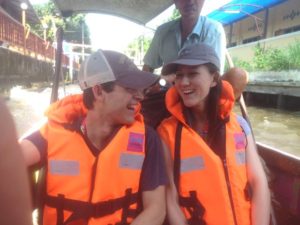 How the long tail boats, which are at least 17 ft long, with a 6 foot prop behind them, can turn a 90% turn in a narrow canal defies the imagination. Not only could they do that, but they could negotiate passing other long tails and hand-paddled sampans with four passengers in canals that are maybe 12 feet wide.
How the long tail boats, which are at least 17 ft long, with a 6 foot prop behind them, can turn a 90% turn in a narrow canal defies the imagination. Not only could they do that, but they could negotiate passing other long tails and hand-paddled sampans with four passengers in canals that are maybe 12 feet wide.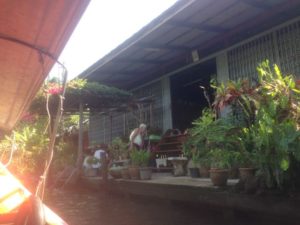
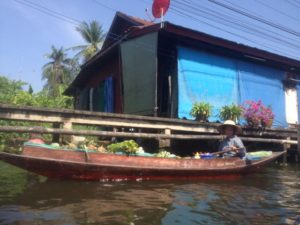
The floating market is a wonderful assault on the senses—smells, sounds, sights, and tastes. When we disembarked from the long tails at the market, I bought fried bananas (very sweet and delicious) and took pictures of the vendors flying squirrel curled in a coconut shell.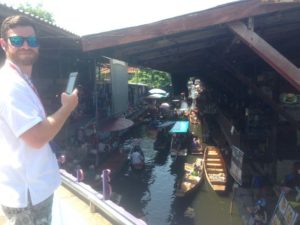
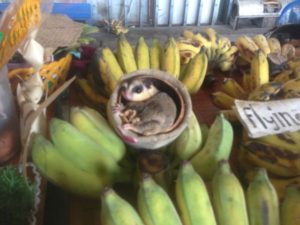
The narrow river was packed with sampans selling vegetables and food of every sort that was cooked on the boat and consumed on the canal side.
There were pythons to be photographed, and every manner of food and goods to be purchased, after bargaining, of course.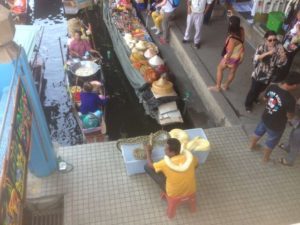
We all bought embroidered cotton shirts. The heat was the most intense we’ve experienced (in the 90’s and humidity that had you sweating like you were in a sauna).
We were all glad to get back to the air conditioned bus for the hour drive to a lunch stop at a Thai Tesco (lovely meal of crispy duck and pork with soup and rice for 49 Baht ($1.50).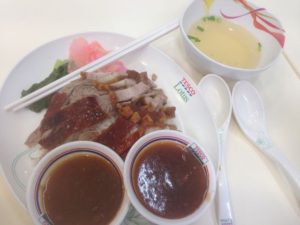
The Railway Museum in Kanchanaburi, a moving testament to the Allied POW’s who died building the Bangkok to Burma railway that the Japanese needed to supply their troops in order to attack the British in Burma. The Japanese drew a straight line from Bangkok to their destination in Burma and decided to build the railway in two years through dense jungle and mountainous terrain with no tools other than dynamite and sledge hammers.
They used Allied POWs (primarily British, Australian and New Zealanders, with some Dutch and American prisoners) and over a hundred thousand Burmese and Malaysian workers, all of whom were treated like slaves and forced to work 18 hour days with little food and no medical supplies. They were forced to live in crowded open air huts and men died of malaria, cholera, diarrhea, malnutrition, and injury.
More than 12,000 POWs and 80,000 Burmese and Malaysians died during the construction. The Thais were officially neutral but did not resist the Japanese incursion into their country, so they were never conscripted to work on the railway. Seven thousand well-tended Allied graves fill the Kanchanburi cemetery.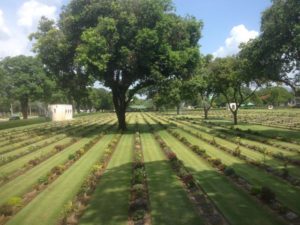
The building of the railway was made famous by the movie Bridge Over the River Kwai. Having just watched it, I would say the movie sanitizes the conditions the men lived under. A better movie is The Railway Man starring Colin Firth. It tells the story of a British POW still suffering from the aftereffects of his captivity. He returns to the camp where he was imprisoned during the war.
The railway still functions today although it is very slow.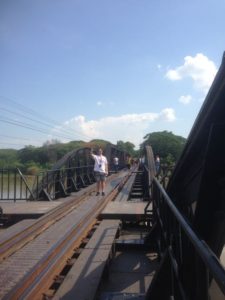 The trip from Bangkok to Kanchanbury takes 6 hours every though it can be driven in 3. We drove to the metal bridge over the River Kwai that was bombed by Americans during the war, but reconstructed. The timber bridge was destroyed completely.
The trip from Bangkok to Kanchanbury takes 6 hours every though it can be driven in 3. We drove to the metal bridge over the River Kwai that was bombed by Americans during the war, but reconstructed. The timber bridge was destroyed completely.
A Buddhist temple sits across the river.
The mountains that we drove towards are limestone, and rock is quarried and sculpted into amazing shapes to be used as ornamental pieces in gardens.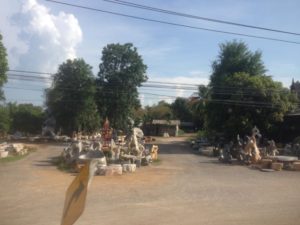
The Melia Resort, 0ur hotel, turned out to be in the middle of the forest on the banks of the river. Bird song greeted us, and we were shocked at how well tended and empty the resort was. Our luxurious rooms overlook the swift river, and we quickly took advantage of the luxe infinity pool.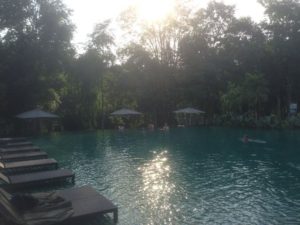
Dinner was out under the stars beside the river.


I enjoyed a whole fried sea bass.




